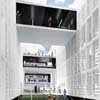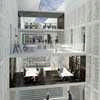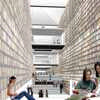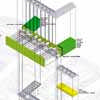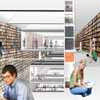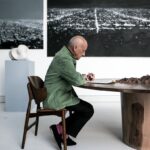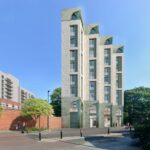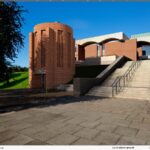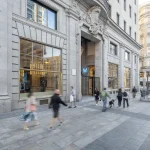Biblioteca Alcalá, Architecture, Building, Architects, Images, Design
Biblioteca y Museo de la Universidad de Alcalá
Alcala University Building, Spain – design by dosmasunoarquitectos
29 Apr 2012
Biblioteca Alcalá
Design: dosmasunoarquitectos
New images added 29 April 2012:
English text (scroll down for spanish):
Biblioteca y Museo de la Universidad de Alcalá
Occupying a historic building
dosmasunoarquitectos thought that the project for the new Central Library of Alcalá de Henares University should not be strictly limited to a refurbishment task, in which a new program and furniture are to supersede the original ones. It should be understood as an insertion into an existing party-wall, acquiring its shape, absorbing light and fresh air, and opening towards the sky as the only possible way out. This implies the creation of a new space within an existing heritage building which features its own identity, and which is as well respectfully introduced into a formerly built context.
The development of spatial strategies to occupy a given volume, as well as the generation of an inner façade to link and accommodate the new uses into the already existent building, are some of the keys through which the project evolved. Besides, it was equally important to develop an independent and flexible constructive process, neutral and nuanced at the same time, which ensured the adaptation of the new program without constraining it physically.
Intervention
Therefore, our proposal had to be respectful with the former urban layout of Cuartel del Príncipe, as well as with its presence and material condition –the whole original wrapping-, so the interior could be completely scooped out, thus transformed into a ‘plot’ where to carry out a Project for a library and a museum. This plot is limited by a built boundary, which binds not only its perimeter, but also its upper and lower ‘façades’: no basements can be dug, neither an extra volume can protrude beyond the existing roofline or alignments towards Patio Cultural or Plaza de San Diego. Hence, our proposal turned out to be a building inside a building, which emphasizes this condition through its ‘non-façade’ and its new storey distribution.
Free space. Connectivity
Thus, the main access to the new library, through the front façade of the existing main building, turns out to be a filter to Patio Cultural, through where the future public courtyard will be reached. Likewise, the new Salón de la Ciudad can be reached through the building destined to host the new museum from San Pedro Street. Therefore, two aims are achieved through this strategy: on the one hand, to provide the city with new connections between the new public spaces and the already existing and, on the other hand, to provide these connections with a clear use –for them not to become superfluous, residual spaces-, concentrating in them the main accesses to the Library and the Museum.
Library of libraries
The Project for the new Central Library is a ‘Library of Libraries’: a complex system of supports and accesses to these supports which must be organized from a single, controlled entrance. Hence, a clear programmatic organization seems crucial in order to understand the whole building’s operation, subsequently enforcing the parts’ functionality.
Main body + auxiliary bay
Through a deeper analysis of the required program, a primary organigram is distilled. It concentrates the General Hall and the Specialty Collections Area inside the main bay facing San Diego Square, leaving other uses such as the mediatheque, computer rooms or newspaper library in the northern auxiliary bay.
Accesibility and cores: restricted access-free access, 24h use, load / unload bay Adjacent to the main body and within the secondary wings of the main building, two vertical cores are set. The northern one is the buildings’ main vertical core, as it links the main access with the whole bunch of auxiliary libraries. The access to the southern core is restricted to the library staff: it is independent from the main controlled access, and it links every single workspace with the restricted areas. The timetable flexibility of the General Hall and the Specialty Collections Area is granted by concentrating both these inside the main bay, accessed through a 24h controlled entrance. The non-24h-use program is set beyond the northern core, into the auxiliary bay, so it can be easily isolated when necessary.
Piano nobile, access and vertical communication.
Just as some of the most notorious classic libraries, such as Asplund’s Stockholm Library or Plecniks’s Ljubljana Library, the General Hall -the library’s main space- is set on the building’s piano nobile. As the main access control is left behind, the General Hall can be reached through an immaterial staircase. Then, the General Hall appears as a huge void of air and light, flanked by two ‘book-walls’ which isolate this space from any external bother, separating, at the same time, the uses of the main hall: the lecture room and the searching area.
The general void is crossed by several volumes which host teamwork study rooms, nuancing this main space and somehow complexizing the achieved naturalness of the programmatic organization.
Seat organization: general hall / specialty collection. Individual seats + teamwork halls
The General Hall is a deep, continuous space, but it cannot be walked through, for the reading places are placed from side to side of the hall, relegating the circulations to the peripheral book-flanked loggias. On the one hand, the General Hall hosts 500 seats (for individual or group study), while the Specialty Collections Area is furnished with 300 places within the same continuous space, but placed on top of the hovering volumes which cross the light and air void. Although these volumes dwell inside of the main space, they are acoustically isolated, enhancing teamwork efficiency.
Auxiliary bay organization
The remaining program is developed within the auxiliary bay located beyond the northern vertical core. Depending on the hosted use, each storey is organized following two different strategies. However, both are continuous and transformable, therefore granting any possible variation which may take place throughout the building’s lifetime.
The auxiliary libraries scheme, together with the computer rooms, is based on a peripheral circulation system, which offsets the working space from the façade, providing the whole space with smooth, natural lighting. The second scheme, implemented in personal working spaces or meeting rooms, consists of a central corridor which allows every single room to be placed along the façade of the building. Both systems are installed once the main structure is cast, so they can be exchanged if necessary.
The heritage building
The whole constructive process is carried out taking an extreme care for the heritage building in which the new program is inserted in, as well as for the historic surroundings, for the building itself actually plays a role in a heritage complex of an indisputable value which, therefore, must be preserved.
However, this criteria does not prevent both parts of the building -the ancient wrapping and the new interior- from being regarded independently.
External homogeneity
A full restoration of the façade is proposed, so the building shall retrieve and consolidate its presence without distorting its original appearance in terms of wall openings or materials used. Moreover, the inner façades facing the Patio Cultural will be dignified, and this space is also to be restored in a neutral way.
Inner volume insertion
The insertion of the new volume into the existent Cuartel del Príncipe skin is carried out with a clear ‘material confrontation’ criterion. Concrete, wood, steel, glass and polycarbonate now face the elder brick and masonry external walls. Just like an uncut jewel placed inside an old chest.
Structure / canopy
The structure of the library’s main space is based on two bearing ‘book-walls’ which flank the General Hall. They are huge ‘cages’ made up of steel bookshelves and supports, which bear the volumes that cross the main void, as well as the light peripheral corridor slabs.
The structure of the northern wing is made up of supports and slabs of cast-in-situ concrete.
The canopy preserves and re-uses the original roof trusses, modifying their actual position to allow skylight into the main space.
Biblioteca – Universidad de Alcalá de Henares – Building Information
Title: Central Library and Museum for the University of Alcalá de Henares
Competition. First Prize. 2007
Client: Universidad de Alcalá de Henares
Architects: Ignacio Borrego, Néstor Montenegro, Lina Toro
Collaborators: Begoña de Abajo, Jean-Baptiste Barbet, Marius Ege, Sálvora Feliz, Marko Licen, Qianyi Lim, Paula Raimúndez, Carlos Ramos, Alberto Rey, Daniel Ruiz, Jerónimo van Schendel
Surveyors: Javier Mach, Javier González
Structure: Arquing
Services: Grupo JG
Spanish text:
Biblioteca Universidad de Alcalá de Henares
BIBLIOTECA CENTRAL Y MUSEO DE LA UNIVERSIDAD DE ALCALÁ
Concurso. 1er Premio
Autores: Ignacio Borrego (arquitecto), Néstor Montenegro (arquitecto) y Lina Toro (arquitecta)
Colaboradores: Jean-Baptiste Barbet, Alberto Rey y Daniel Ruiz (estudiantes de arquitectura)
BREVE
Entendemos que el proyecto para la nueva Biblioteca y Museo de la Universidad de Alcalá no debe limitarse a un trabajo de interior. Debe entenderse el proyecto como aquel que se inserta en una medianera existente de la que absorbe luz y ventilación y de la que toma su forma, abriéndose al cielo como única salida transformable. Es un proyecto de creación de un nuevo espacio, dentro de un edificio de valor histórico, con su propio carácter, respetuoso una vez más con el entorno, que en esta ocasión está edificado.
El desarrollo de estrategias espaciales de ocupación de un volumen dado, así como la de generación de una fachada interior que vincule y acomode los usos con la envolvente existente, son dos de los posibles caminos que el proyecto aborda en su evolución.
Biblioteca – Universidad de Alcalá de Henares – Ficha Técnica
Biblioteca Central y Museo de la Universidad de Alcalá de Henares
Concurso. Primer premio. 2007
Promueve: Universidad de Alcalá de Henares
Arquitectos: Ignacio Borrego, Néstor Montenegro, Lina Toro
Colaboradores: Begoña de Abajo, Jean-Baptiste Barbet, Marius Ege, Sálvora Feliz, Marko Licen, Qianyi Lim, Paula Raimúndez, Carlos Ramos, Alberto Rey, Daniel Ruiz, Jerónimo van Schendel
Aparejadores: Javier Mach y Javier González
Estructuras: Arquing
Instalaciones: Grupo JG
Biblioteca Alcalá images / information from dosmasunoarquitectos
Biblioteca Alcalá arquitectos : dosmasunoarquitectos
Location: Alcalá, Madrid, Spain
Madrid Buildings
Contemporary Madrid Architecture
Madrid Architecture Walking Tours by e-architect
Madrid Architecture – Selection
B&B hotel in Getafe, Madrid metropolitan area
Architect: CuldeSacTM Custom
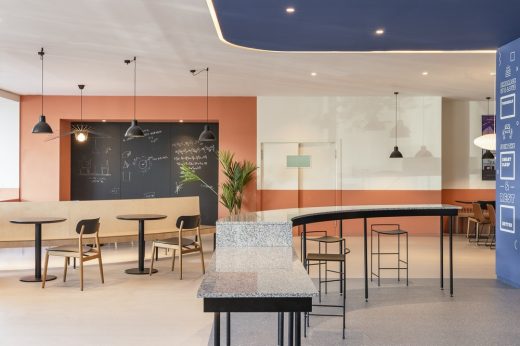
photo : David Zarzoso
Getafe Hotel Building
Architects: luis vidal +arquitectos
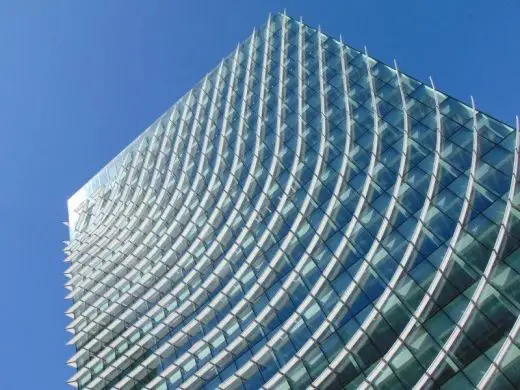
photos © luis vidal + arquitectos. All rights reserved
Castellana 77 Building
Casa Madrid
A-Cero Architects
Casa Madrid
Foster + Partners
Torre Caja
, PAU de Sanchinarro, northeast Madrid
MVRDV
Celosia Madrid
Comments / photos for the Biblioteca Alcalá Architecture page welcome

